Abstract
Root tips (10-millimeter length) were excised from hypoxically pretreated (HPT, 4% [v/v] oxygen at 25°C for 16 hours) or nonhypoxically pretreated (NHPT, 40% [v/v] oxygen) maize (Zea mays) plants, and their rates of respiration were compared by respirometry under aerobic and anaerobic conditions with exogenous glucose. The respiratory quotient under aerobic conditions with 50 millimolar glucose was approximately 1.0, which is consistent with glucose or other hexose sugars being utilized as the predominant carbon source in glycolysis. Under strictly anaerobic conditions (anoxia), glycolysis was accelerated appreciably in both HPT and NHPT root tips, but the rate of anaerobic respiration quickly declined in NHPT roots. [U-14C]Glucose supplied under anaerobic conditions was taken up and respired by HPT root tips up to five times more rapidly than by NHPT roots. When anaerobic ethanol production was measured with excised root tips in 50 millimolar glucose, HPT tissues consistently produced ethanol more rapidly than NHPT tissues. These data suggest that a period of low oxygen partial pressure is necessary to permit adequate acclimation of the root tip of maize to subsequent anoxia, resulting in more rapid rates of fermentation and generation of ATP.
Full text
PDF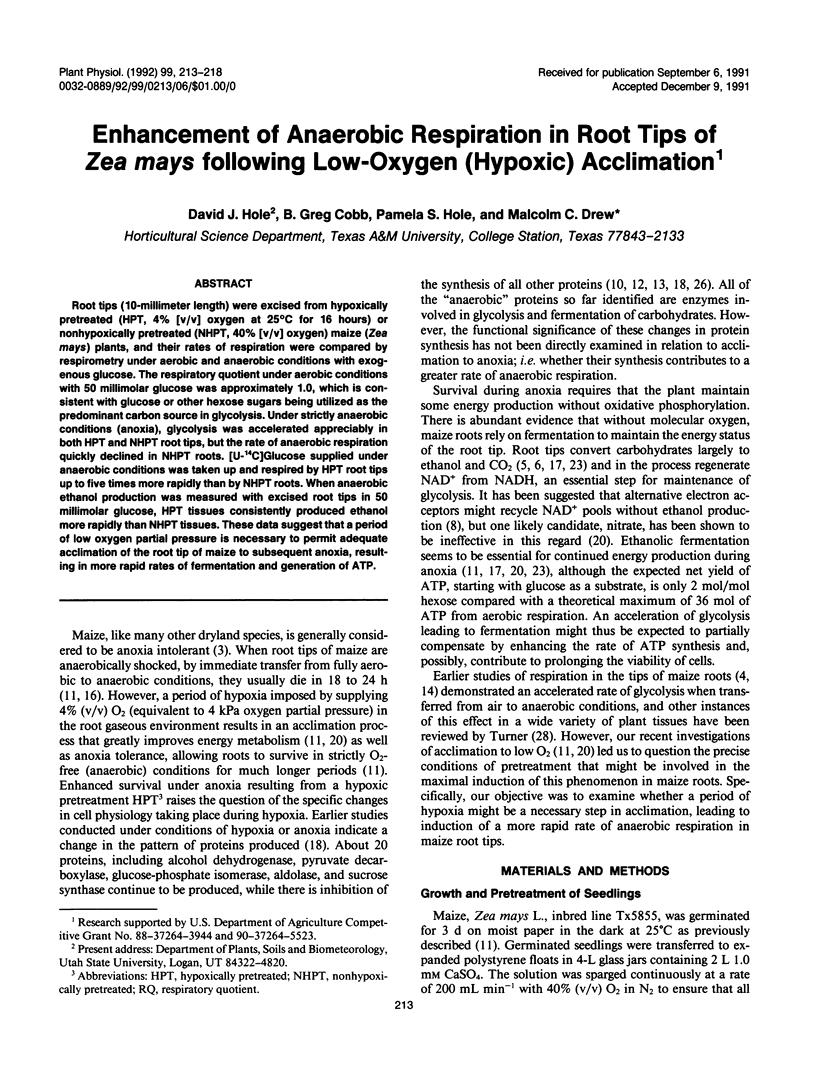

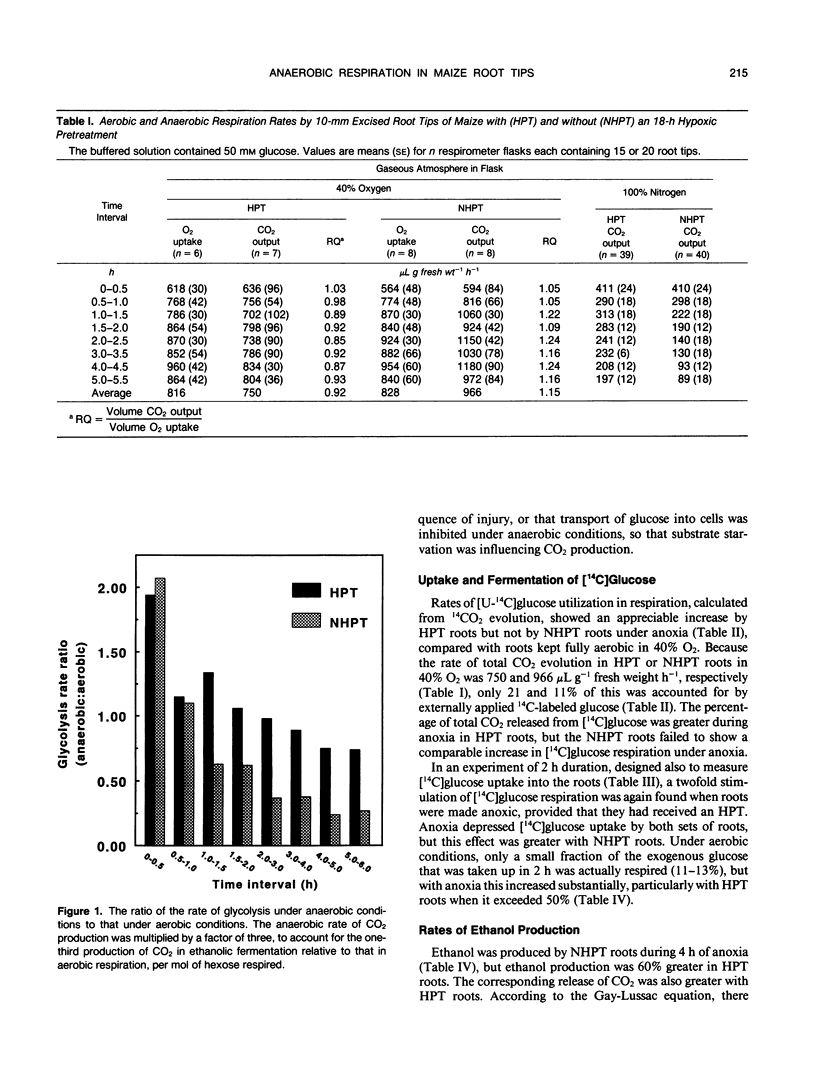
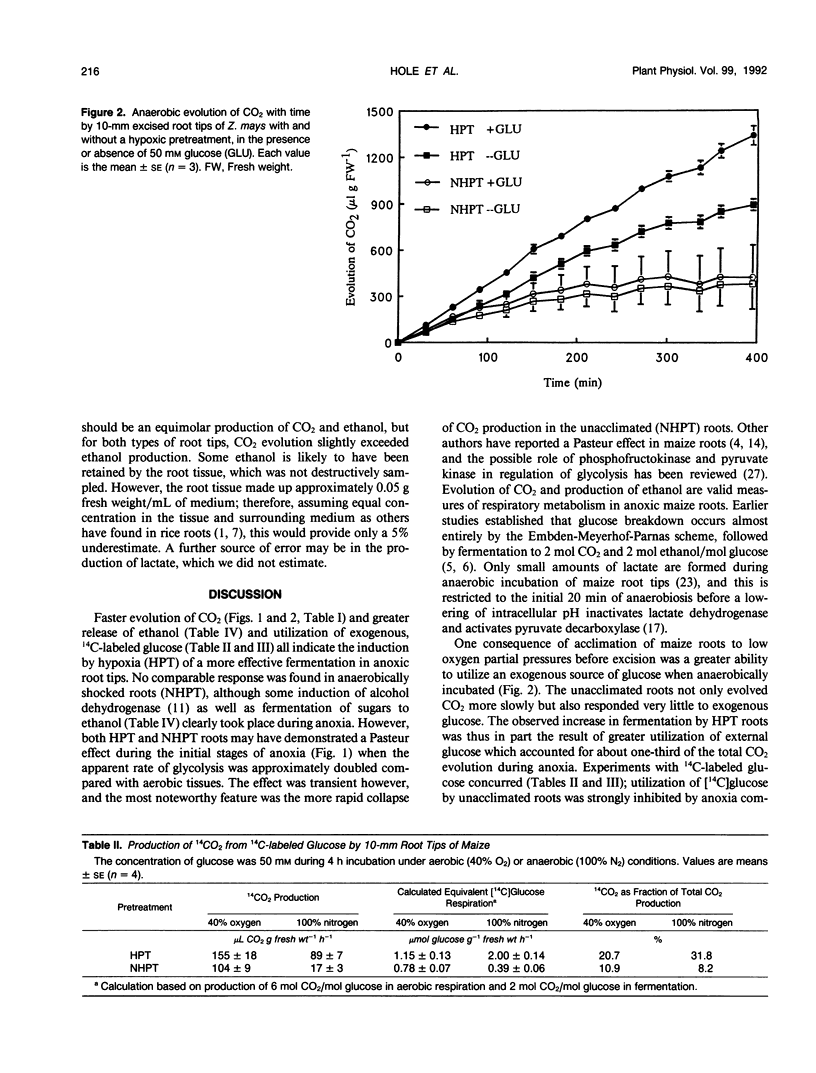
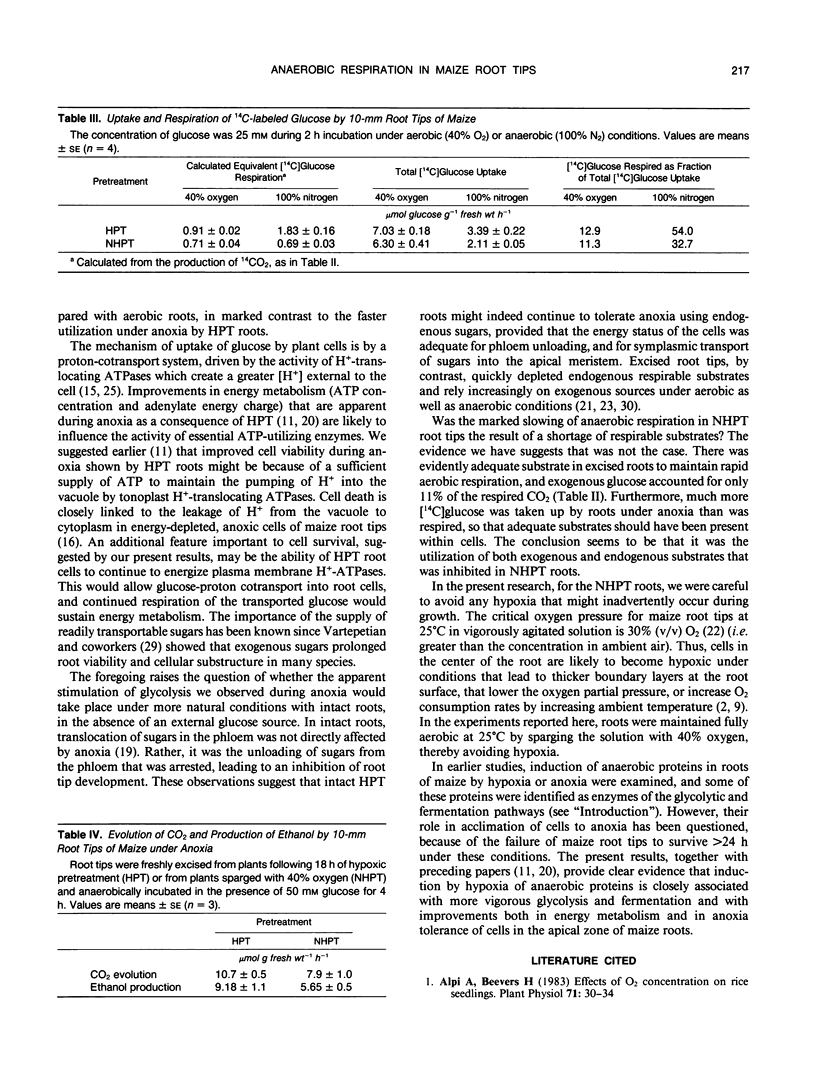
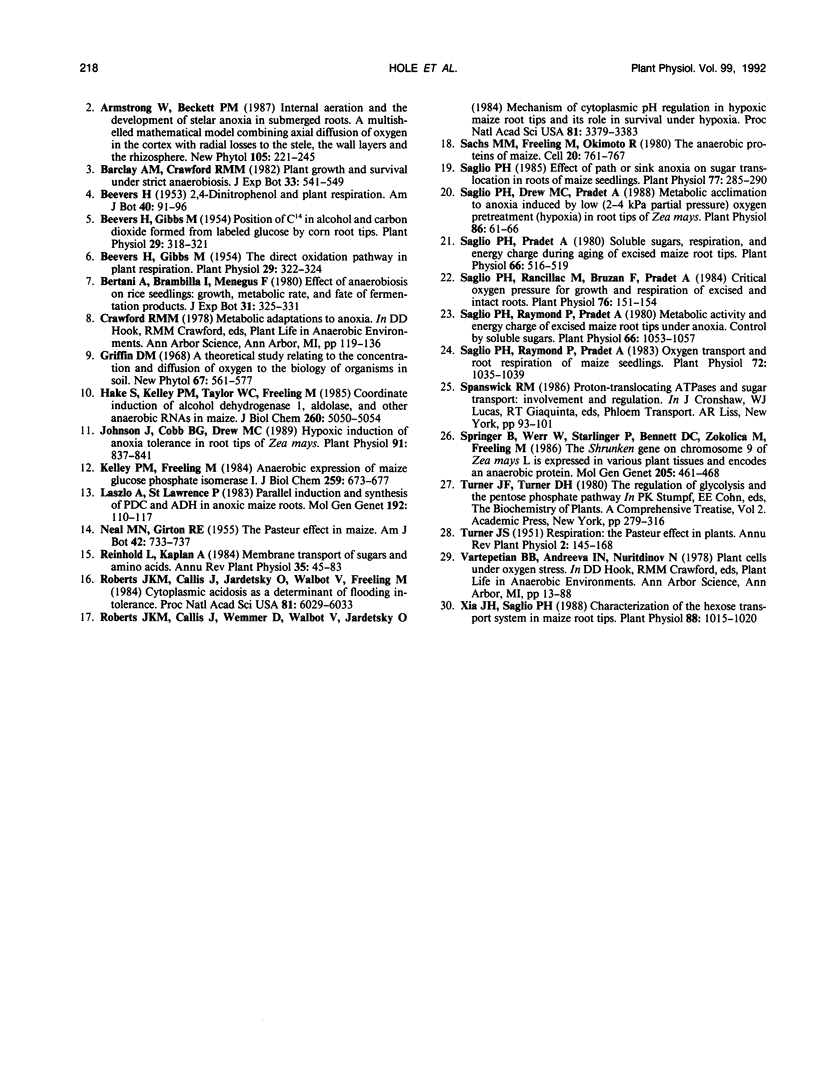
Selected References
These references are in PubMed. This may not be the complete list of references from this article.
- Alpi A., Beevers H. Effects of o(2) concentration on rice seedlings. Plant Physiol. 1983 Jan;71(1):30–34. doi: 10.1104/pp.71.1.30. [DOI] [PMC free article] [PubMed] [Google Scholar]
- Beevers H., Gibbs M. Position of C in Alcohol and Carbon Dioxide Formed from Labeled Glucose by Corn Root Tips. Plant Physiol. 1954 Jul;29(4):318–321. doi: 10.1104/pp.29.4.318. [DOI] [PMC free article] [PubMed] [Google Scholar]
- Beevers H., Gibbs M. The Direct Oxidation Pathway in Plant Respiration. Plant Physiol. 1954 Jul;29(4):322–324. doi: 10.1104/pp.29.4.322. [DOI] [PMC free article] [PubMed] [Google Scholar]
- Hake S., Kelley P. M., Taylor W. C., Freeling M. Coordinate induction of alcohol dehydrogenase 1, aldolase, and other anaerobic RNAs in maize. J Biol Chem. 1985 Apr 25;260(8):5050–5054. [PubMed] [Google Scholar]
- Johnson J., Cobb B. G., Drew M. C. Hypoxic Induction of Anoxia Tolerance in Root Tips of Zea mays. Plant Physiol. 1989 Nov;91(3):837–841. doi: 10.1104/pp.91.3.837. [DOI] [PMC free article] [PubMed] [Google Scholar]
- Kelley P. M., Freeling M. Anaerobic expression of maize glucose phosphate isomerase I. J Biol Chem. 1984 Jan 10;259(1):673–677. [PubMed] [Google Scholar]
- Roberts J. K., Callis J., Jardetzky O., Walbot V., Freeling M. Cytoplasmic acidosis as a determinant of flooding intolerance in plants. Proc Natl Acad Sci U S A. 1984 Oct;81(19):6029–6033. doi: 10.1073/pnas.81.19.6029. [DOI] [PMC free article] [PubMed] [Google Scholar]
- Roberts J. K., Callis J., Wemmer D., Walbot V., Jardetzky O. Mechanisms of cytoplasmic pH regulation in hypoxic maize root tips and its role in survival under hypoxia. Proc Natl Acad Sci U S A. 1984 Jun;81(11):3379–3383. doi: 10.1073/pnas.81.11.3379. [DOI] [PMC free article] [PubMed] [Google Scholar]
- Sachs M. M., Freeling M., Okimoto R. The anaerobic proteins of maize. Cell. 1980 Jul;20(3):761–767. doi: 10.1016/0092-8674(80)90322-0. [DOI] [PubMed] [Google Scholar]
- Saglio P. H., Drew M. C., Pradet A. Metabolic Acclimation to Anoxia Induced by Low (2-4 kPa Partial Pressure) Oxygen Pretreatment (Hypoxia) in Root Tips of Zea mays. Plant Physiol. 1988 Jan;86(1):61–66. doi: 10.1104/pp.86.1.61. [DOI] [PMC free article] [PubMed] [Google Scholar]
- Saglio P. H. Effect of path or sink anoxia on sugar translocation in roots of maize seedlings. Plant Physiol. 1985 Feb;77(2):285–290. doi: 10.1104/pp.77.2.285. [DOI] [PMC free article] [PubMed] [Google Scholar]
- Saglio P. H., Pradet A. Soluble Sugars, Respiration, and Energy Charge during Aging of Excised Maize Root Tips. Plant Physiol. 1980 Sep;66(3):516–519. doi: 10.1104/pp.66.3.516. [DOI] [PMC free article] [PubMed] [Google Scholar]
- Saglio P. H., Rancillac M., Bruzan F., Pradet A. Critical oxygen pressure for growth and respiration of excised and intact roots. Plant Physiol. 1984 Sep;76(1):151–154. doi: 10.1104/pp.76.1.151. [DOI] [PMC free article] [PubMed] [Google Scholar]
- Saglio P. H., Raymond P., Pradet A. Metabolic Activity and Energy Charge of Excised Maize Root Tips under Anoxia: CONTROL BY SOLUBLE SUGARS. Plant Physiol. 1980 Dec;66(6):1053–1057. doi: 10.1104/pp.66.6.1053. [DOI] [PMC free article] [PubMed] [Google Scholar]
- Saglio P. H., Raymond P., Pradet A. Oxygen Transport and Root Respiration of Maize Seedlings: A Quantitative Approach Using the Correlation between ATP/ADP and the Respiration Rate Controlled by Oxygen Tension. Plant Physiol. 1983 Aug;72(4):1035–1039. doi: 10.1104/pp.72.4.1035. [DOI] [PMC free article] [PubMed] [Google Scholar]
- Springer B., Werr W., Starlinger P., Bennett D. C., Zokolica M., Freeling M. The Shrunken gene on chromosome 9 of Zea mays L is expressed in various plant tissues and encodes an anaerobic protein. Mol Gen Genet. 1986 Dec;205(3):461–468. doi: 10.1007/BF00338083. [DOI] [PubMed] [Google Scholar]
- Xia J. H., Saglio P. H. Characterization of the hexose transport system in maize root tips. Plant Physiol. 1988 Dec;88(4):1015–1020. doi: 10.1104/pp.88.4.1015. [DOI] [PMC free article] [PubMed] [Google Scholar]


